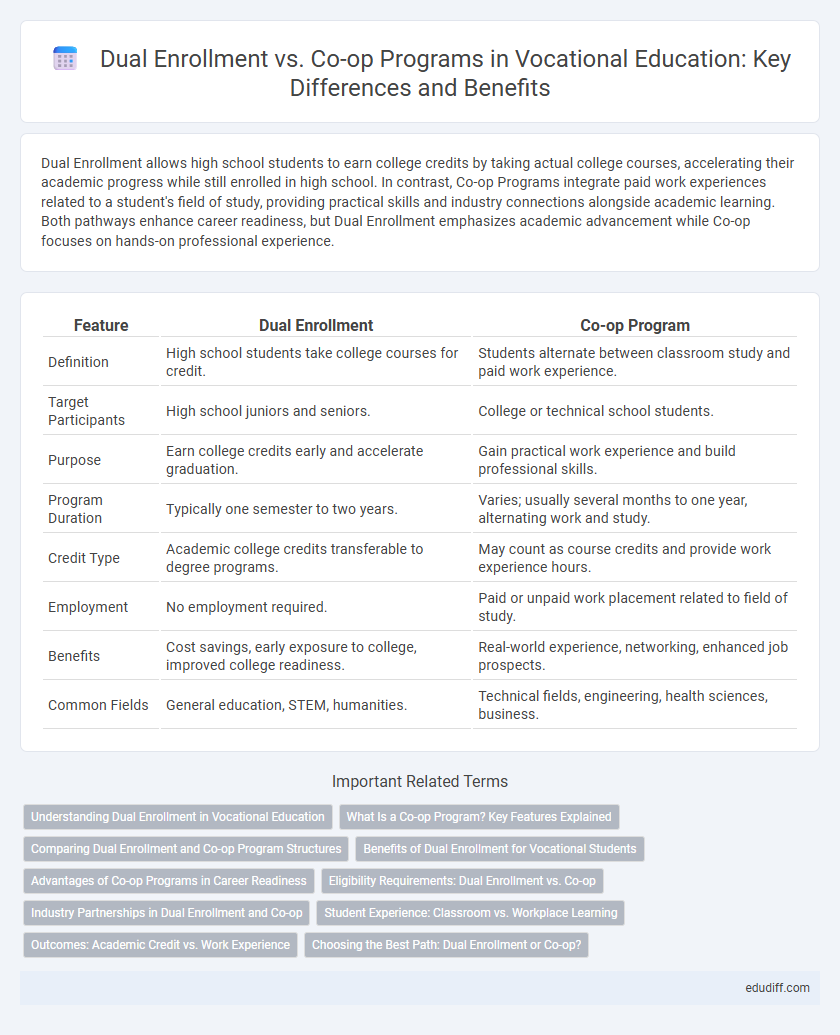Dual Enrollment allows high school students to earn college credits by taking actual college courses, accelerating their academic progress while still enrolled in high school. In contrast, Co-op Programs integrate paid work experiences related to a student's field of study, providing practical skills and industry connections alongside academic learning. Both pathways enhance career readiness, but Dual Enrollment emphasizes academic advancement while Co-op focuses on hands-on professional experience.
Table of Comparison
| Feature | Dual Enrollment | Co-op Program |
|---|---|---|
| Definition | High school students take college courses for credit. | Students alternate between classroom study and paid work experience. |
| Target Participants | High school juniors and seniors. | College or technical school students. |
| Purpose | Earn college credits early and accelerate graduation. | Gain practical work experience and build professional skills. |
| Program Duration | Typically one semester to two years. | Varies; usually several months to one year, alternating work and study. |
| Credit Type | Academic college credits transferable to degree programs. | May count as course credits and provide work experience hours. |
| Employment | No employment required. | Paid or unpaid work placement related to field of study. |
| Benefits | Cost savings, early exposure to college, improved college readiness. | Real-world experience, networking, enhanced job prospects. |
| Common Fields | General education, STEM, humanities. | Technical fields, engineering, health sciences, business. |
Understanding Dual Enrollment in Vocational Education
Dual enrollment in vocational education allows high school students to simultaneously earn college credits while completing career-focused courses, accelerating their pathway to technical certifications or degrees. This program integrates academic and hands-on training, providing practical skills and reducing the time and cost of postsecondary education. Students gain early exposure to industry standards and workforce demands, enhancing employability upon graduation.
What Is a Co-op Program? Key Features Explained
A co-op program integrates paid work experience with academic studies, allowing students to alternate between classroom learning and hands-on employment in their field. Key features include structured work terms, career-relevant job placements, and employer mentorship, which enhance practical skills and professional networking. Unlike dual enrollment that combines high school and college courses, co-op programs emphasize real-world job experience as part of vocational education.
Comparing Dual Enrollment and Co-op Program Structures
Dual Enrollment programs enable high school students to earn college credits by taking academic courses, fostering early exposure to higher education with a focus on theoretical knowledge. Co-op programs integrate classroom learning with paid, supervised work experiences, emphasizing practical skills and real-world application in a chosen vocational field. The primary structural difference lies in Dual Enrollment's academic credit system versus Co-op's alternating work-study schedule designed to enhance employability and professional development.
Benefits of Dual Enrollment for Vocational Students
Dual enrollment programs allow vocational students to earn college credits while completing high school coursework, accelerating their career pathways and reducing the overall cost of postsecondary education. These programs provide early exposure to college-level curriculum and hands-on training that enhance technical skills and improve employability in competitive job markets. Access to dual enrollment often leads to higher graduation rates and smoother transitions from education to skilled trades careers.
Advantages of Co-op Programs in Career Readiness
Co-op programs provide students with paid, hands-on work experiences directly related to their vocational field, enhancing practical skills and industry knowledge more effectively than traditional dual enrollment courses. These programs foster professional networking opportunities and real-world problem-solving abilities, which significantly improve career readiness and employability. Employers often value co-op experience as it demonstrates a candidate's ability to apply academic concepts in workplace settings.
Eligibility Requirements: Dual Enrollment vs. Co-op
Dual Enrollment eligibility typically requires high school students to maintain a minimum GPA and obtain approval from school counselors, allowing them to take college-level courses while earning both high school and college credits. Co-op Program eligibility often involves meeting specific vocational skill prerequisites, employer approval, and availability of work-study placements, emphasizing practical experience alongside academic learning. Both programs aim to enhance career readiness but cater to different student needs and academic pathways.
Industry Partnerships in Dual Enrollment and Co-op
Dual enrollment programs leverage strong industry partnerships to provide high school students with direct access to college-level coursework and real-world experience, often collaborating with local businesses and colleges to align curricula with workforce demands. Co-op programs build deeper immersive work experiences through structured employment placements, partnering extensively with industry leaders to offer paid, hands-on training that enhances technical skills and professional development. Both pathways depend heavily on strategic collaborations with employers to ensure relevant skill acquisition and seamless transition into the vocational labor market.
Student Experience: Classroom vs. Workplace Learning
Dual Enrollment offers students the chance to earn college credits while still in high school, emphasizing a structured classroom environment that fosters theoretical knowledge and academic skills. Co-op Programs immerse students directly in workplace settings, providing practical experience, real-world problem solving, and professional networking opportunities. Both approaches enhance student learning but differ in balancing academic instruction with hands-on employment.
Outcomes: Academic Credit vs. Work Experience
Dual Enrollment allows students to earn academic credit by completing college-level courses while still in high school, accelerating their pathway to graduation and higher education. Co-op Programs prioritize hands-on work experience by integrating paid or unpaid employment within a student's field of study, enhancing practical skills and professional networking opportunities. Both approaches offer distinct outcomes, with Dual Enrollment emphasizing credential acquisition and Co-op delivering industry-specific experience essential for career readiness.
Choosing the Best Path: Dual Enrollment or Co-op?
Choosing the best path between dual enrollment and co-op programs depends on career goals and learning preferences. Dual enrollment offers college credits while still in high school, accelerating academic progress and reducing postsecondary costs. Co-op programs provide hands-on work experience and skill development, enhancing employability and real-world readiness in vocational fields.
Dual Enrollment vs Co-op Program Infographic

 edudiff.com
edudiff.com